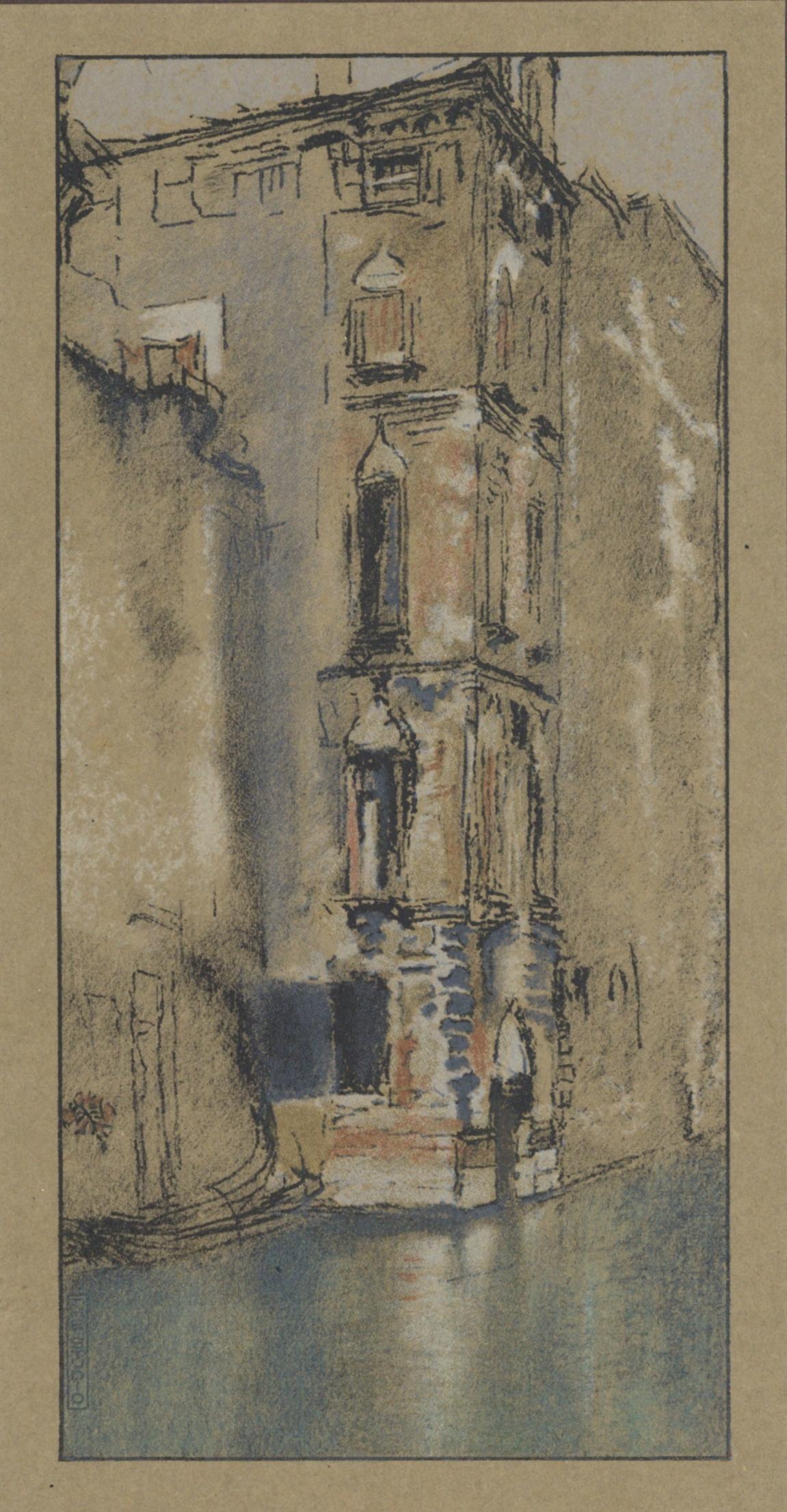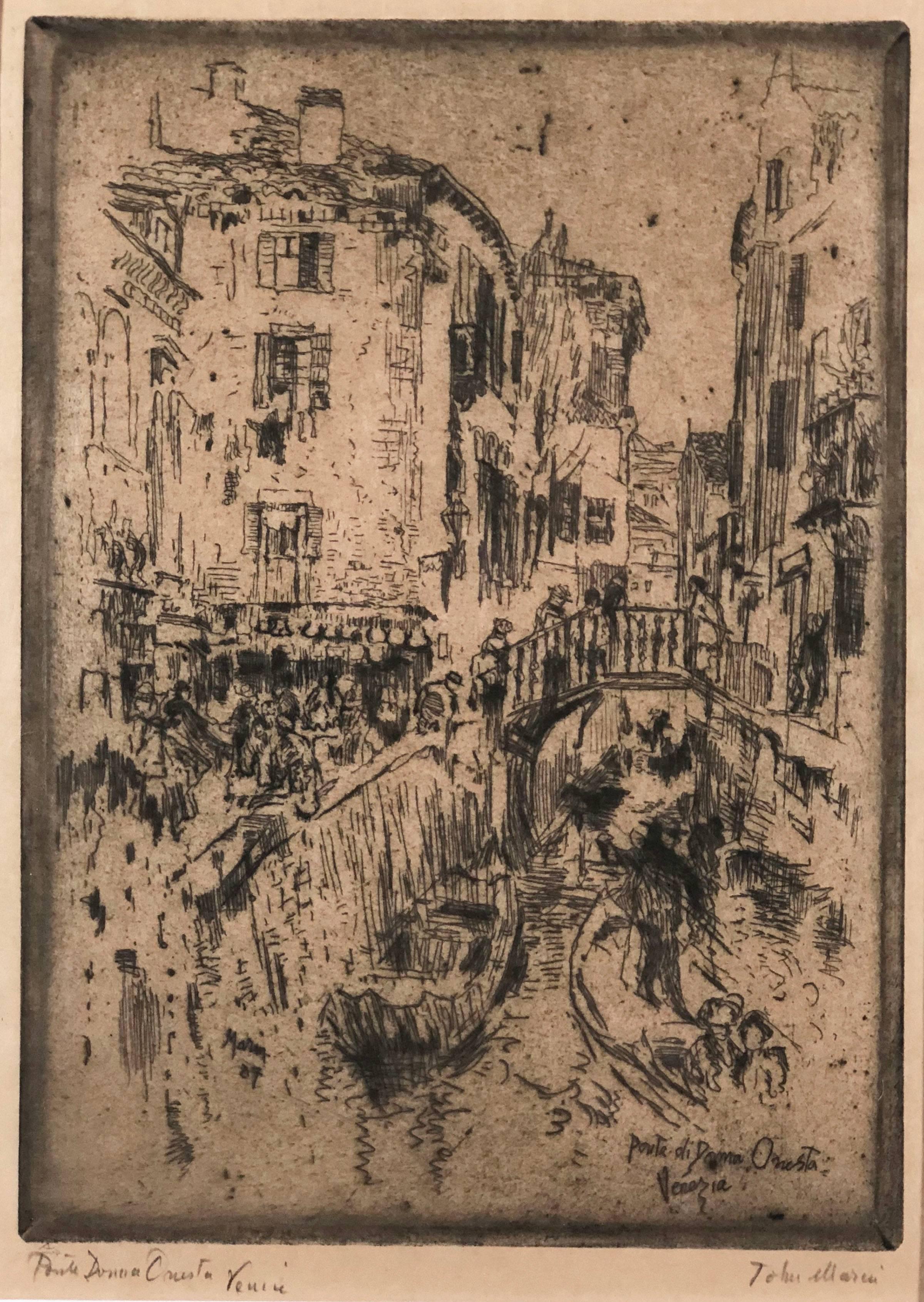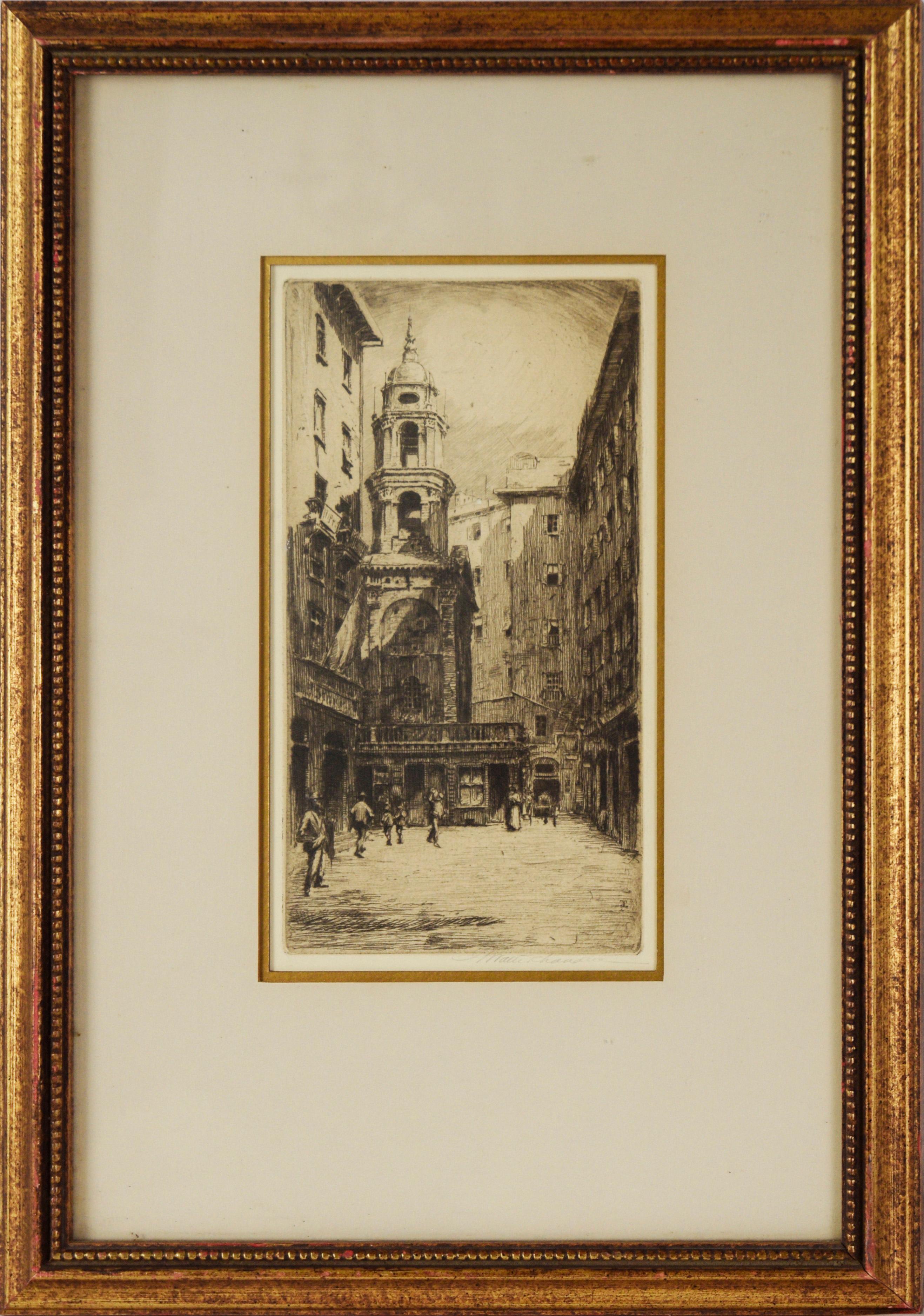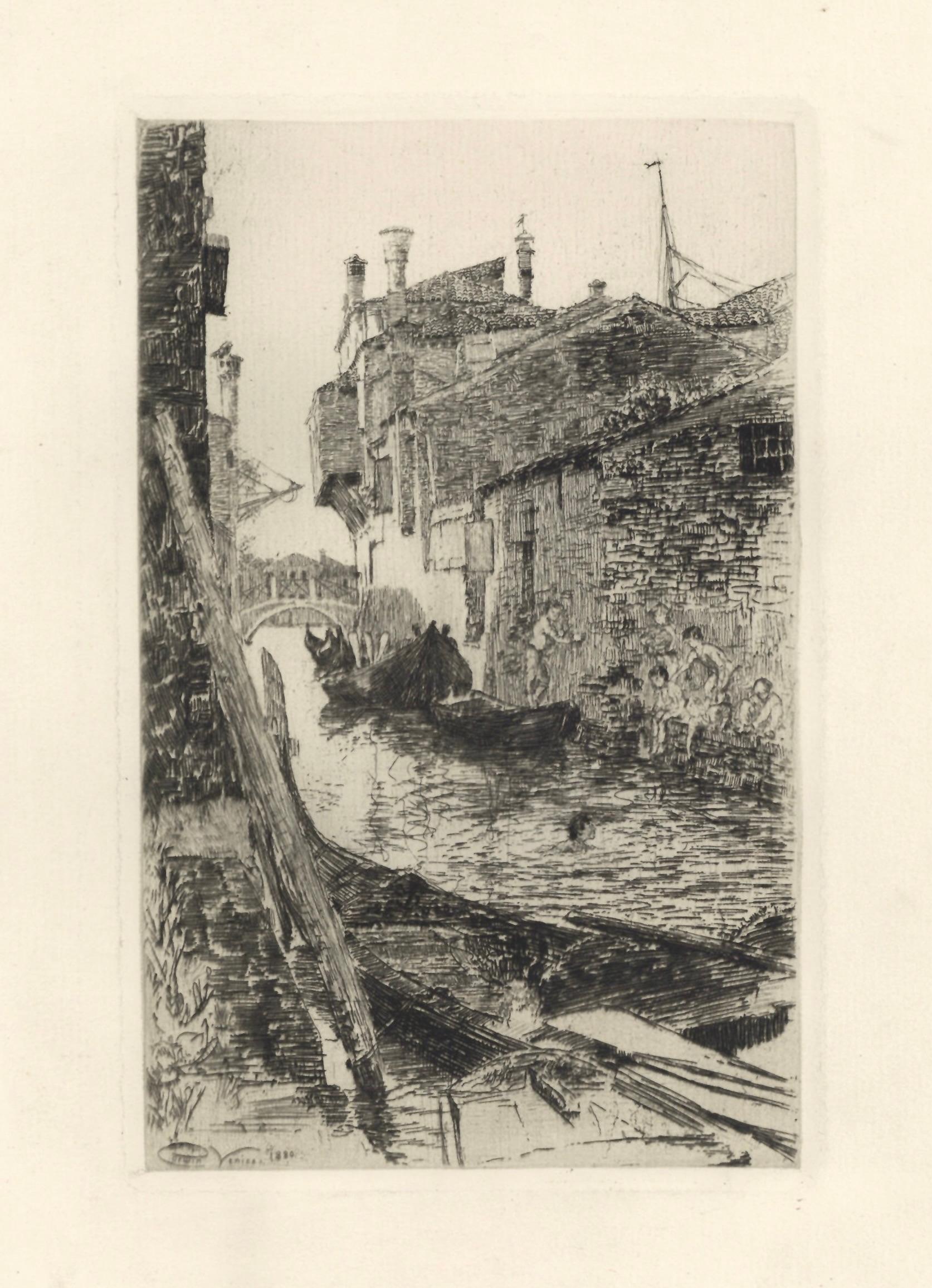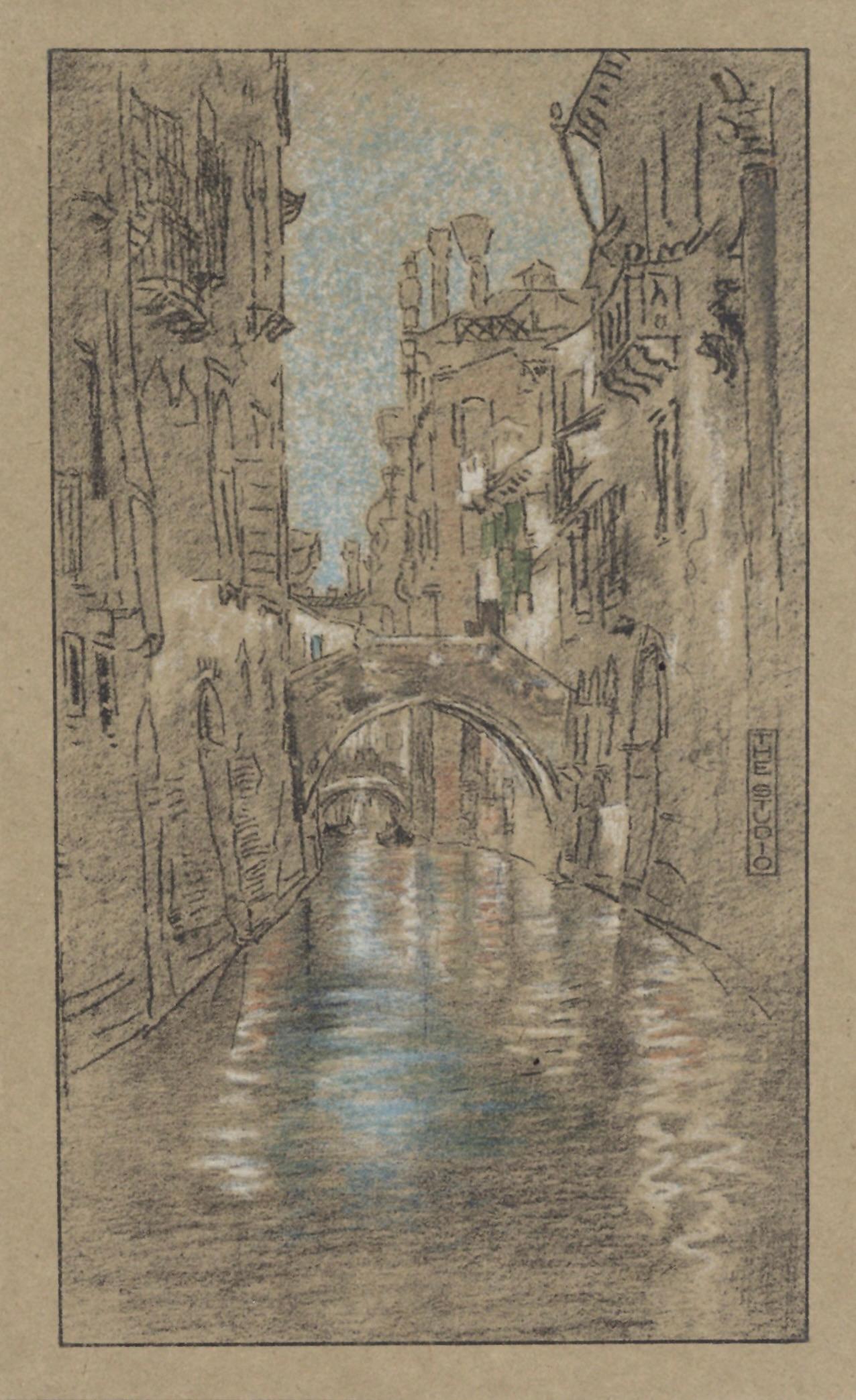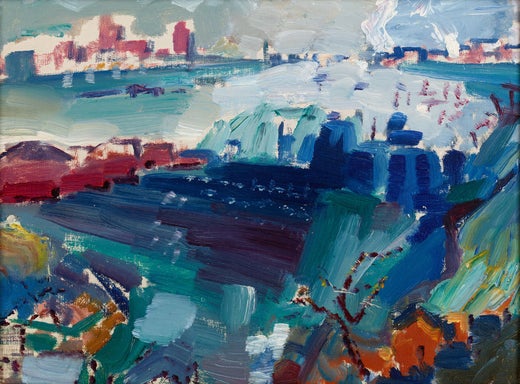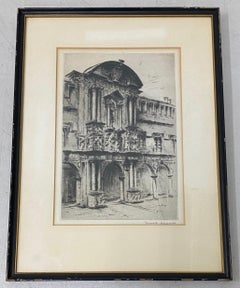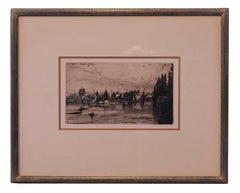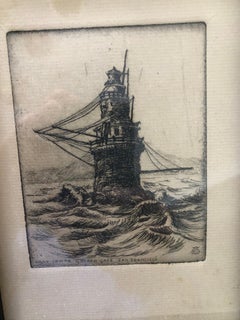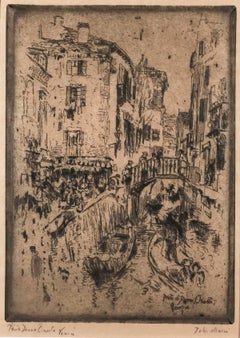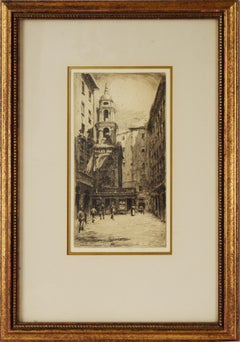Items Similar to John Marin "Clock Tower of Santa Maria Zobenigo, Venice, Italy" Etching c.1907
Want more images or videos?
Request additional images or videos from the seller
1 of 16
John MarinJohn Marin "Clock Tower of Santa Maria Zobenigo, Venice, Italy" Etching c.19071907
1907
$1,500
£1,132.01
€1,295.98
CA$2,115.50
A$2,322.55
CHF 1,211.68
MX$28,106.12
NOK 15,186.53
SEK 14,309.71
DKK 9,674.14
About the Item
John Marin "Clock Tower of Santa Maria Zobenigo, Venice, Italy" Original Pencil Signed Etching c.1907
Rare pencil signed etching by listed American artist John Marin (1870-1953)
Plate dimensions 5.5" wide x 8" high
The frame measures 11.5" wide x 15" high
Pencil signed lower right
John Marin was born in Rutherford, New Jersey in 1870. As a child of seven or eight Marin began to sketch and when he was a teenager he had completed his earliest watercolors. His education in the schools of New Jersey was interspersed with summers of hunting, fishing and sketching; he traveled in the Catskills, and as far away as Wisconsin and Minnesota. But formal training was almost incidental to his development as an artist.
Marin established himself as a practicing architect. In the early 1890s, he worked for four architects and by 1893 had designed six houses in Union Hill, New Jersey. At the age of twenty-eight, he decided to become a professional artist and studied briefly at the Pennsylvania Academy of Fine Arts in Philadelphia and the Art Students League in New York City.
Santa Maria Zobenigo; The church, whose name translates into St. Mary of the Lily referring to the flower classically depicted as being presented by the Angel Gabriel during the Annunciation, is more commonly known as Santa Maria Zobenigo after the Jubanico family who founded it in the 9th century. The edifice is situated on the Campo Santa Maria Zobenigo, west of the Piazza San Marco. It was rebuilt by Giuseppe Sardi for Admiral Antonio Barbaro between 1678 and 1681 and has one of the finest Venetian Baroque facades in all of Venice. The church is now part of the parish of San Moisè.
A fine opportunity!
- Creator:John Marin (1870-1953, American)
- Creation Year:1907
- Dimensions:Height: 15 in (38.1 cm)Width: 11.5 in (29.21 cm)Depth: 1 in (2.54 cm)
- Medium:
- Movement & Style:
- Period:
- Condition:Lightly used vintage frame.
- Gallery Location:San Francisco, CA
- Reference Number:1stDibs: LU137827387122
John Marin
John Marin was born in Rutherford, New Jersey in 1870. His father was a public accountant; his mother died nine days after his birth. He was taken to his maternal grandparents with whom he lived in Weehawken, New Jersey. His grandparents, with their son and two daughters were the only parents Marin was to know; it has been suggested that his father seems to have ignored him. As a child of seven or eight Marin began to sketch and when he was a teenager he had completed his earliest watercolors. His education in the schools of New Jersey was interspersed with summers of hunting, fishing and sketching; he traveled in the Catskills, and as far away as Wisconsin and Minnesota. But formal training was almost incidental to his development as an artist. He is to America what Paul Cezanne was to France - an innovator who helped to oppose the influence of the narrative painters, the illustrators who were more interested in subject than form, in surface than substance. Marin brought to his work a combination of values which, at the turn of the century, was unique in this country: an aliveness of touch, colors that have both sparkle and solidity, and forms that are vibrant with an energy characteristic of our age. Marin established himself as a practicing architect. In the early 1890s, he worked for four architects and by 1893 had designed six houses in Union Hill, New Jersey. At the age of twenty-eight, he decided to become a professional artist and studied briefly at the Pennsylvania Academy of Fine Arts in Philadelphia and the Art Students League in New York City. As a watercolorist he had no equal. He used this fluid, spontaneous medium to abstract from objects - skyscrapers, boats, mountains and seas - a simplified anatomy of color and form and to define the pulsation of stresses and movements in the relationship of objects. It was a great disappointment, all his life, that his oil paintings did not achieve the popularity that his watercolors did. From 1905 to 1910 he worked in Europe, where he was influenced by Whistler's watercolors. It was Alfred Stieglitz, Marin's lifetime friend and dealer, whose firm faith in his genius made his position in the art world possible. He developed a distinctive style that he used most characteristically in powerful watercolors of the Maine coast. During the 1920s he provided the dominant force in the movement away from naturalistic representation towards an art of expressive semi-abstraction. He married Marie Jane Hughes after he returned to New York. They had one son, who grew up to run his father's considerable affairs. Marin continued to work at the same steady fast pace as long as he lived. Since 1908 he had produced 1700 paintings, an average of forty a year. He had made the frames for them as well. At the age of seventy-nine, he began to taper off from the days when he painted one hundred watercolors in a summer. He died in 1953.
About the Seller
4.9
Gold Seller
Premium sellers maintaining a 4.3+ rating and 24-hour response times
1stDibs seller since 2020
553 sales on 1stDibs
Typical response time: 5 hours
- ShippingRetrieving quote...Shipping from: San Francisco, CA
- Return Policy
Authenticity Guarantee
In the unlikely event there’s an issue with an item’s authenticity, contact us within 1 year for a full refund. DetailsMoney-Back Guarantee
If your item is not as described, is damaged in transit, or does not arrive, contact us within 7 days for a full refund. Details24-Hour Cancellation
You have a 24-hour grace period in which to reconsider your purchase, with no questions asked.Vetted Professional Sellers
Our world-class sellers must adhere to strict standards for service and quality, maintaining the integrity of our listings.Price-Match Guarantee
If you find that a seller listed the same item for a lower price elsewhere, we’ll match it.Trusted Global Delivery
Our best-in-class carrier network provides specialized shipping options worldwide, including custom delivery.More From This Seller
View AllEarly 20th Century European Architecture Drypoint Etching c.1930
Located in San Francisco, CA
Early 20th Century European Architecture Drypoint Etching c.1930
This fine etching is pencil signed in the lower right corner (illegible - see i...
Category
Early 20th Century Impressionist Landscape Prints
Materials
Drypoint
William Alphonse Lambrecht "Place Saint-Leger, Chambery, France" Etching c.1930
By William Adolphe Lambrecht
Located in San Francisco, CA
William Alphonse Lambrecht "Place Saint-Leger, Chambery, France" Original Etching C.1930
Plate dimensions 6.5" wide x 9.75" High
Frame dimensions 12.5" wide x 16.5" high
Pencil si...
Category
Early 20th Century Landscape Prints
Materials
Etching
Sir Francis Seymour Haden (1818-1910. British) "Old Chelsea Church" Etching
By Sir Francis Seymour Haden, R.A.
Located in San Francisco, CA
Sir Francis Seymour Haden (1818-1910. British)
"Old Chelsea Church"
Etching
1865
4 3/8" x 7 3/4" unframed
12.75" x 15.75" framed
Category
1860s Landscape Drawings and Watercolors
Materials
Etching
Light Tower Golden Gate San Francisco Etching
Located in San Francisco, CA
Mystery monogrammed early San Francisco etching. Great little piece of San Francisco history showing a lighthouse in Golden Gate. Etching measure...
Category
Early 20th Century American Realist Landscape Prints
Materials
Etching
Manfred Sillner "The Treasury of Regensburg" Etching c.1975
By Manfred Sillner
Located in San Francisco, CA
Surreal etching by noted German artist Manfred Sillner b.1937
This is a rare etching from 1975. Pencil signed and titled by the artist.
Titled "Treas...
Category
Mid-20th Century Surrealist Still-life Prints
Materials
Etching
James Abbott McNeill Whistler (1834 - 1903, British) "Fulham (Chelsea Church)"
By James Abbott McNeill Whistler
Located in San Francisco, CA
James Abbott McNeill Whistler (1834 - 1903, British)
"Fulham (Chelsea Church)"
Etching
Year 1865
8" x 5 1/8 unframed
13.75 x 17.25" framed
Category
1870s Prints and Multiples
Materials
Etching
You May Also Like
"The Old Marble Hall, Venice" lithograph 1905
Located in Henderson, NV
Medium: lithograph (after the pastel). The lithography was executed by Whistler's friend and fellow artist Thomas Way, and published in London by The Studio in 1905 for a rare deluxe...
Category
Early 1900s Prints and Multiples
Materials
Lithograph
Ponte di Donna Onesta, Venice
By John Marin
Located in Missouri, MO
Very rare etching by John Marin.
"Ponte di Donna Onesta, Venice" 1907
Original Etching
Hand Signed Lower Right
Titled Lower Left
Edition: c. 30
Cat. Rais: ...
Category
Early 1900s Abstract Landscape Prints
Materials
Etching
Price Upon Request
Church of San Pietro In Banchi, Italy - 1908 Original Etching
Located in Soquel, CA
Church of San Pietro In Banchi, Italy - 1908 Original Etching
Original 1908 etching of the church of San Pietro Banchi in Genoa, Italy by George Walter Chandler (American, 1866-1928...
Category
Early 1900s Post-Impressionist Landscape Prints
Materials
Laid Paper, Etching
"Venice" original etching
By Charles Abel Corwin
Located in Henderson, NV
Medium: original etching. This impression on wove paper was printed in 1885 for the Sylvester R. Koehler portfolio of etchings and published by Cassell & Company. Plate size: 8 x 5 1...
Category
1880s Prints and Multiples
Materials
Etching
St. Germain-Des-Pres, Paris
By John Marin
Located in New York, NY
John Marin (1870-1953), St. Germain-Des-Pres, Paris, etching, 1906. Signed in pencil lower right and titled lower left [also signed and dated in the plate]. Zigrosser 47, only state,...
Category
Early 1900s American Impressionist Landscape Prints
Materials
Etching
"A Venetian Canal" lithograph 1905
Located in Henderson, NV
Medium: lithograph (after the pastel). The lithography was executed by Whistler's friend and fellow artist Thomas Way, and published in London by The Studio in 1905 for a rare deluxe...
Category
Early 1900s Prints and Multiples
Materials
Lithograph
More Ways To Browse
Antique Santas
Tower Clock
Antique Italian Etching
Antique Tower Clock
Etchings Of Italy
Antique Italian Clock
Antique Italian Clocks
John Brown Clocks
Angel Gabriel
Latin Artist Painting
Llama Art
Luxembourg Gardens Paris
Magic Poster
Marcel Gimond
Outsider Art Cat
Pablo Picasso Pichet
Pepsi Cola Vintage
Queen Mary Ship
